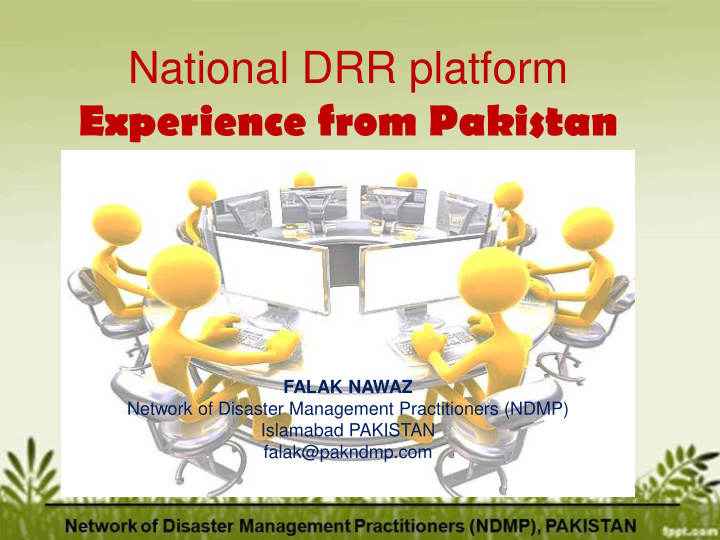



National DRR platform Experience from Pakistan FALAK NAWAZ Network of Disaster Management Practitioners (NDMP) Islamabad PAKISTAN falak@pakndmp.com
Shift in paradigm after devastating 2005 earthquake Government efforts led by NDMA • Establishment of National Working Group • Establishment of Ministerial Working Group • Establishment of Technical Working Group Civil society efforts • Pakistan DRR Forum • National Humanitarian Network (NHN) • Pakistan Humanitarian Forum (PHF)
National Working Group 1. NDMA as Chairing the session 14. Ministry of Information and Broadcast 2. Planning Commission 15. Ministry of Petroleum and Natural 3. Ministry of Water and Power Resources 4. Ministry of Housing and Works 16. National Center of Excellence in 5. Ministry of Industries and geology, University of Peshawar Production 17. Capital Administration and 6. Ministry of Defense Development Division 7. Ministry of Communication 18. PEC (Pakistan Engineering Council) 8. Ministry of Education 19. PCATP (Pakistan Council of 9. Ministry of Health Architects and Town Planners) 10. Ministry of Environment 20. DGs – PDMAs / SDMA / FDMA (07 11. Ministry of Agriculture and Food Members) 12. Ministry of Railways 21. Chairs of PWGs (04 Members) 13. National University of Science and Technology After the devolution, most of the ministries become part of provincial government
Role of National Working Group 1. Mainstreaming DRR into different development programmes 2. Mainstreaming DRR in 10 ministries 3. Strengthening of the ministries through technical support 4. Implementation of DRR checklist in future development project 5. Developed Ministerial Working Group
Inclusion of scientific & academic institutions (Technical working group) • National Disaster Management Authority • Provincial Disaster Management Authorities • National Institute of Disaster Management • Geological Survey of Pakistan • Survey of Pakistan • Pakistan Meteorological Department • Federal Flood Commission • National Engineering Services Pakistan (NESPAK) • Space and Upper Atmosphere Research Commission (SUPARCO) • National University of Science and Technology • National Center of Excellence in Geology, University of Peshawar
Role of Technical Working Group To provide strategic guidance; To coordinate all activities related to MHVRA in the country; To ensure the consistency in methodologies employed for disaster risk assessments; Uniformity in data format during collection process; Coordinating in disaster risk assessments efforts; To ensure no gaps exist; To avoid overlapping of efforts.
Developed web portal National platform for data sharing www.disasterinfo.gov.pk http://203.124.43.252/
Developed web portal (National platform) • With funding support of World Bank, NDMA established National Platform of Technical working group; • Develop web portal using Geo-node for scientific & technical organization to share data and make analysis; • For quick dissemination of information for effective emergency response; • Disaster risk reduction planning; • Enhance decision making; • Web portal is further maintaining now by NDMA under WFP funding support to further enhance the information,
Data Sharing Platform • Geospatial Content Management System • Web-based application platform for Sharing of geospatial data Developing geospatial data Deployment of Spatial data infrastructures Data Catalogue
Decision Support System (DSS) • A Geographic Information System based tool to facilitate informed decision making in an emergency situation; • Basic map visualization (pan, zoom, address search, geo-location, print map); • Information popups, statistical graphs & pie charts; • Data querying capability based on attributes and geography; • Comparison maps; • Visualization and analysis of hazard exposure and risk scenarios.
Challenges
Group of Users • Each member of the National Working Group is a user of the plate form. • There are four group each representing TWG sub group. Flood Earthquake Vulnerability and Exposure Risk Assessment
Challenges to maintain the platform • Activation and deactivation of platform time to time; • Lack of coordination between scientific & technical organizations & non-government stakeholders especially for data sharing; • Hesitation to share the data especially among government stakeholders; • Ownership of platform; • Operationalization of National Institute of Disaster Management; • Ensuring sustainability, regular liaison and coordination; • Agreeing on one points especially in case of MHVRA; • Less participation from academic and research organizations;
Conclusion • Advocacy especially at scientific and technical organization level responsible for emergency response management and development practices; • Need to develop guidelines for ensuring sustainability of platform and data sharing; • Develop long term strategy to ensure capacity enhancement of DRR practitioners on use of scientific and technical data; • More close coordination and regular liaison among technical organizations; • Lead role of National and Provincial DM authorities; • Aggressive involvement of scientific & research organization; • More aggressive role of NIDM
Recommend
More recommend